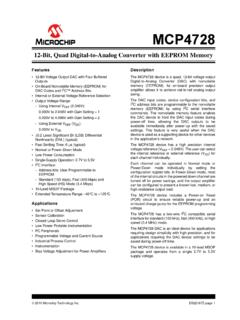Transcription of ARDUINO 2WD SMART ROBOT CAR KIT - riedberg-edu.eu
1 ARDUINO 2WD SMART ROBOT CAR KIT Level: Beginner GK-KIT-003 P a g e | 2 PARTS LIST: Please ensure that the following pieces are included in your kit! Component Quantity Image Notes ARDUINO Sensor Shield 1 Please see note about jumpers below L298N Dual H-Bridge Motor Driver 1 Please see note about jumpers below ARDUINO Uno 1 - 40 Pin Breakable Headers 1 Not Required for this Kit Free Gift! servo Mounting Brackets 1 Ignore the Top plate provided servo Base 1 Comes in same bag as servo mounting Brackets servo Motor (SG90) 1 Comes in same bag as servo mounting Brackets USB Cable 1 Color and Length may vary HC-SR04 Ultrasonic Sensor 1 - DC Motors 2 - Rubber Wheels 2 Comes wrapped with Motors Acrylic ROBOT Chassis 1 Comes wrapped with Motors AA Battery Holder 1 Comes wrapped with Motors Motor Mounting Brackets 4 Comes wrapped with Motors Stranded 24 AWG Wire Black and Red Set 2 Comes wrapped with Motors ON-OFF Switch 1 Comes wrapped with Motors M3 Screw, Spacer and Nut Set 1 FIT0066 Jumper Wire Set 1 Rainbow wires Nylon Coasting Wheel 1 - Advanced Note.
2 Ensure Both Motor board and Sensor Shield have the indicated jumper displayed with a yellow circle. If the pins are missing the jumper, feel free to short the pins by bending them to touch each other or use a breadboard wire. P a g e | 3 Recommended Tools: Needle Nose Plier Flush Wire Cutter (Optional) Wire Stripper Heat Shrink (Optional) Soldering Iron Brass Sponge (Optional) Screwdriver (+) Frame Assembly: Unwrap the paper that has the frame, motor, battery holder and various components secured together. Peel both sides the acrylic paper. You can start from either side top corner and work your way down.
3 For this manual I will only remove one side for ease in visual demonstration. Motor Mounting Brackets are used to fixed the DC motors to the frame. Slide the bracket into the slot indicated in the red circle and flip the unit to start mounting the motors! Ensure the dot is facing inwards when assembling the frame to the chassis. Shown with a green circle. The wire leads will be facing outwards. The motors will be facing the bottom. Shown with the red arrow. Using a soldering iron, solder the red wire to the pin that is the farthest from the frame and the black cable to the pin that is the closest to the frame. (You can also wire twist the cable onto the motor) Place another Motor Bracket on the outside, the grove will allow for the bracket to slide in.
4 Using the long screw provided, slide it into the two brackets and motor. To fasten the nut, gently squeeze the motor and bracket and push the unit outwards. You may also use a needle nose to fasten the nut. Use the brass spacers and Philips screws and mount the nylon wheel on the same side as the motors. The wheel will align over the circled holes. Must insert two long screws. Repeat for the other side. Flip over and secure with screws. Pinch horizontally indicated with red arrows. The switch should slide in smoothly without braking the frame. On the same side where you can see the switch markings I and O, Install two nylon M3 standoffs indicated with red arrows. Use hex nuts provided with the standoffs on the other side.
5 The area with the green circle, place a standoff and secure on the other side using another standoff. (Do not use a hex nut) This will act as a stress relief for the ARDUINO and a mount on the other side for the H-bridge. Use two philips screw to fasten the ARDUINO to the frame. This is the same side with the switch marking. ENSURE THIS BOARD HAS THE JUMPER IN YELLOW IN IT. Should you find that the jumper is missing, use one strand from the rainbow jumper wire set to make a short circuit or bend the pins to the point where they are touching each other. Switch button is facing the opposite side of the motors. Verify the jumpers located with the yellow circle are also attached. Place the Shield over the ARDUINO microcontroller as shown.
6 A section below will explain how this shield works. Flip the car over where the motor and nylon wheels are located. You can see the nylon spacer for the h-bridge. Place another nylon spacer in the red circle and secure it on the other side with a phlips screw. It should look something like this when you place the h-bridge. Use only one hex screw to fasten the h-bridge to the chassis. Flip the car over to the side with the ARDUINO . From the servo pack install the servo plastic frame by sliding the motor into the bracket on one side and repeating for the other. Secure it using a sharp screw bit found in the servo pack. Using a screwdriver or drill bit, enlarge the hole to hold three m3 screws.
7 Slide the top servo bracket into the bottom frame. The gears should align and fit. Ensure by hand that the motor can turn left and right 90 or more, if this is not possible remove and readjust before proceeding! Take a small sharp screw and insert into the location of the red circle. Place the few remain spacers and shown in the image. Fasten on the other side where the motors are located with some hex nuts. Flip the unit and insert another nylon spacer for the battery holder. Fasten on the other side with a hex nut. Note: Insert the nylon spacer where the red circle is, ignore where the nylon spacer is currently in the photo. Insert the servo bracket and mount over the three nylon spacers and fasten the screws into the female thread of the spacers.
8 Note: you can turn the bracket at an angle to access the screws. Flip the unit and fasten the battery holder on the single standoff. You can also insert the wheels now or later after completing the wiring. Wiring Guide: You can use a jumper wire and strip the ends for the cable to supply power to the ARDUINO terminal block from the motor shield terminal block. How the Sensor Shield Works: The select jumper allows the voltage from the terminal block to enter and become regulated to 5 VDC for the ARDUINO microcontroller. If the jumper is not present, you must connect a dc connector into the ARDUINO dc port. The highlighted column is referred to as the 5v bus. Instead of having multiple servos or sensors connecting into a single 5 VDC port this bus reduces crowding and makes connections convenient.
9 Same principal as the 5V bus, this is called the ground bus. Pinout on the left image highlighted are equivalent to the image on the right with the red box. This is used for digital sensors. The highlighted section is for analog signals and is equivalent to the image on the right with the red box. Programming ARDUINO with the Code 1) Plug ARDUINO Microcontroller into computer using the blue USB cable provided 2) Install the Software to read and write program to the chip from , the program is free! << >> 3) Download the driver from this link: << >> For windows please download from here: << >> 4) Open the ARDUINO software and select the com port to program the microcontroller. 5) Download our premade software from our website or following this link << >> 6) Extract the file and open one of the example codes, it will open in the ARDUINO software, press upload and the car should be up and running.
10








